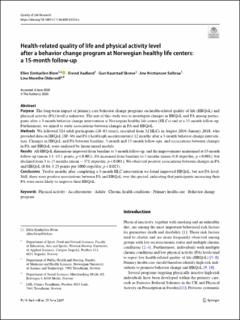| dc.contributor.author | Blom, Ellen Eimhjellen | |
| dc.contributor.author | Aadland, Eivind | |
| dc.contributor.author | Skrove, Guri Kaurstad | |
| dc.contributor.author | Solbraa, Ane Kristiansen | |
| dc.contributor.author | Oldervoll, Line Merethe | |
| dc.date.accessioned | 2020-09-02T11:33:39Z | |
| dc.date.available | 2020-09-02T11:33:39Z | |
| dc.date.created | 2020-07-17T10:26:51Z | |
| dc.date.issued | 2020 | |
| dc.identifier.citation | Blom, E. E., Aadland, E., Skrove, G. K., Solbraa, A. K., & Oldervoll, L. M. (2020). Health-related quality of life and physical activity level after a behavior change program at Norwegian healthy life centers: a 15-month follow-up. Quality of Life Research. | en_US |
| dc.identifier.issn | 0962-9343 | |
| dc.identifier.uri | https://hdl.handle.net/11250/2676034 | |
| dc.description.abstract | Purpose
The long-term impact of primary care behavior change programs on health-related quality of life (HRQoL) and physical activity (PA) level is unknown. The aim of this study was to investigate changes in HRQoL and PA among participants after a 3-month behavior change intervention at Norwegian healthy life center (HLCs) and at a 15-month follow-up. Furthermore, we aimed to study associations between changes in PA and HRQoL.
Methods
We followed 524 adult participants (18–83 years), recruited from 32 HLCs in August 2016–January 2018, who provided data on HRQoL (SF-36) and PA (ActiGraph accelerometers) 12 months after a 3-month behavior change intervention. Changes in HRQoL and PA between baseline, 3-month and 15-month follow-ups, and associations between changes in PA and HRQoL were analyzed by linear mixed models.
Results
All HRQoL dimensions improved from baseline to 3-month follow-up, and the improvements maintained at 15-month follow-up (mean 3.1–13.1 points, p < 0.001). PA increased from baseline to 3 months (mean 418 steps/day, p < 0.001), but declined from 3 to 15 months (mean − 371 steps/day, p < 0.001). We observed positive associations between changes in PA and HRQoL (0.84–3.23 points per 1000 steps/day, p < 0.023).
Conclusions
Twelve months after completing a 3-month HLC intervention we found improved HRQoL, but not PA level. Still, there were positive associations between PA and HRQoL over this period, indicating that participants increasing their PA were more likely to improve their HRQoL. | en_US |
| dc.description.sponsorship | This work was funded by multiple funding bodies: The Norwegian Directorate of Health, Buskerud County Authority, Nordland
County Authority, Sogn and Fjordane County Authority, and Trøndelag
County Authority, the Norwegian University of Science and Technology, Møreforsking Molde, and Western Norway University of Applied
Sciences. | en_US |
| dc.language.iso | eng | en_US |
| dc.publisher | Springer | en_US |
| dc.rights | Navngivelse 4.0 Internasjonal | * |
| dc.rights.uri | http://creativecommons.org/licenses/by/4.0/deed.no | * |
| dc.subject | Physical activity | en_US |
| dc.subject | Accelerometer | en_US |
| dc.subject | Adults | en_US |
| dc.subject | Chronic health conditions | en_US |
| dc.subject | Primary health care | en_US |
| dc.subject | Behavior change program | en_US |
| dc.title | Health-related quality of life and physical activity level after a behavior change program at Norwegian healthy life centers: a 15-month follow-up | en_US |
| dc.type | Peer reviewed | en_US |
| dc.type | Journal article | en_US |
| dc.description.version | publishedVersion | en_US |
| dc.rights.holder | © The Author(s) 2020 | en_US |
| dc.source.journal | Quality of Life Research | en_US |
| dc.identifier.doi | 10.1007/s11136-020-02554-x | |
| dc.identifier.cristin | 1819678 | |
| cristin.ispublished | true | |
| cristin.fulltext | original | |
| cristin.qualitycode | 2 | |

